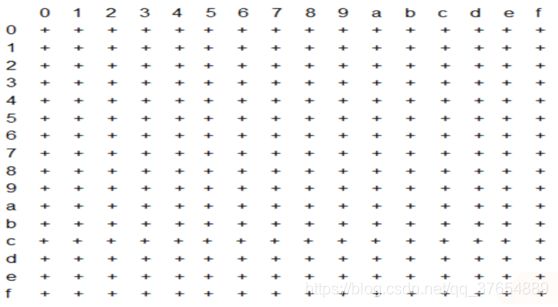Java系列——五子棋的实现
Java之面向对象编程
五子棋(控制台版)是「面向对象编程」中经典的小项目,下面我将提供一种解决视角,仅供参考。
题目描述:
编程实现控制台版并支持两人对战的五子棋游戏。
(1)绘制棋盘 - 写一个成员方法实现
(2)提示黑方和白方分别下棋并重新绘制棋盘 - 写一个成员方法实现。
(3)每当一方下棋后判断是否获胜 - 写一个成员方法实现。
(4)提示: 采用二维数组来模拟并描述棋盘,棋盘如下:

注意点:
- 五子棋棋盘有且只有一张:单例模式实现
- 绘制棋盘函数:按行打印二维数组,双层for循环实现
- 判断落子是否合理:落子是否超出界限,落子是否已存在
- 胜利与否的判断:四个方向的判断
- 每个方向的判断方法:9个字符的数组中是否存在5个连续的与当前棋子一样的字符
Gobang类:
import java.util.Scanner;
public class Gobang {
// 初始化成员变量,落子区域:16*16
// 用单例模式实现有且只有一个棋盘
private char[][] chessboard = new char[17][17];
private static Gobang gb = new Gobang();
// 私有化无参构造方法: 绘制棋盘且提示黑子先手
private Gobang() {
for(int i = 0; i < 17; i++) {
for(int j = 0; j < 17; j++) {
if (0 == i && 0 == j) {
chessboard[i][j] = (char)32;
} else if (0 == i && j <= 10) {
//控制第一行的情况
chessboard[i][j] = (char)(j - 1 + 48);
} else if (0 == i && j <= 16) {
chessboard[i][j] = (char)(j - 11 + 97);
} else if (0 == j && i <= 10) {
// 控制第一列的情况
chessboard[i][j] = (char)(i - 1 + 48) ;
} else if (0 == j && i <= 16) {
chessboard[i][j] = (char)(i - 11 + 97);
} else {
chessboard[i][j] = (char)43;
}
}
}
drawChessboard(true);
}
// 单例模式:从类层级获取棋盘
public static Gobang getGobang() {
return gb;
}
// 绘制棋盘的成员方法
public void drawChessboard(boolean flag) {
System.out.println("--------------------趣味五子棋游戏-------------------");
System.out.println("-----------------作者:Vigoroushui------------------");
for(int i = 0; i < 17; i++){
for(int j = 0; j < 17; j++) {
System.out.print(chessboard[i][j]);
System.out.print(" ");
}
System.out.println();
}
if(true == flag) {
System.out.println("--------------------轮到黑方下棋--------------------");
} else {
System.out.println("--------------------轮到白方下棋--------------------");
}
}
// 判断落子合理性的成员方法
public String judgeRationality(String n) {
int judge = 0;
// 判断当前落子是否超出界限 [0,9]&&[a,f]
for(int i = 1; i < 17; i++) {
if(String.valueOf(chessboard[0][i]).equals(n)) {
judge = 1;
break;
}
}
// 如果落子越界,给定"outer"标示符
if(1 != judge) {
return "outer";
}
return n;
}
// 开始五子棋游戏的成员方法
public void playChess() {
boolean flag = true; //用于控制黑白两方落子的标示符,true代表黑方落子,false代表白方落子
Scanner sc = new Scanner(System.in);
while(true) {
//合理值的判断
System.out.println("请输入您要落子的行位置和列位置(如: a 4):");
int cow, column;
while(true) {
String a = judgeRationality(sc.next());
String b = judgeRationality(sc.next());
// 判断落子是否越界
if ("outer".equals(a) || "outer".equals(b)) {
System.out.println("您落子落到棋盘外面去了,请重新落子:");
}else {
// 将输入的值转为二维数组对应的行列下标
cow = (int) a.charAt(0) + 1 - 48;
column = (int) b.charAt(0) + 1 - 48;
if (cow >= 11) {
cow = (int) a.charAt(0) + 11 - 97;
}
if (column >= 11) {
column = (int) b.charAt(0) + 11 - 97;
}
//判断落子是否已存在
if ('&' == chessboard[cow][column] || '#' == chessboard[cow][column]) {
System.out.println("您落子的位置已有棋子,请重新落子:");
}else {
break;
}
}
}
// 落子
if(flag) {
chessboard[cow][column] = (char) 38; // 用 & 代表黑方落子
} else {
chessboard[cow][column] = (char) 35; // 用 # 代表白方落子
}
// 判断是否胜利,若胜利,则退出循环
boolean win = isWin(cow, column);
if(win && flag){
System.out.println("恭喜黑子获胜!");
drawChessboard(true);
break;
}else if(win && !flag) {
System.out.println("恭喜白子获胜!");
drawChessboard(false);
break;
}
// 交换对手并重新绘制棋盘
flag = !flag;
drawChessboard(flag);
}
}
// 判断是否胜利的成员方法
public boolean isWin(int cow, int column) {
int highBound = 16;
int lowBound = 1;
// 每次落子连成线只可能有4种情况: 横、纵、左斜、右斜
// 创建4个一维数组分别保存四个方向上9个子
char[] cowChess = {
'*', '*', '*', '*', '*', '*', '*', '*', '*'};
char[] columnChess = {
'*', '*', '*', '*', '*', '*', '*', '*', '*'};
char[] leftDiagonal = {
'*', '*', '*', '*', '*', '*', '*', '*', '*'};
char[] rightDiagonal = {
'*', '*', '*', '*', '*', '*', '*', '*', '*'};
rightDiagonal[4] = leftDiagonal[4] = columnChess[4] = cowChess[4] = chessboard[cow][column];
// 生成4个方向的成线数组, 例如:横方向 + + + + & & + + +
for (int i = 1; i <= 4; i++) {
// 生成横方向的成线情况
if (column - i >= lowBound) {
cowChess[4 - i] = chessboard[cow][column - i];
}
if (column + i <= highBound) {
cowChess[4 + i] = chessboard[cow][column + i];
}
// 生成纵方向的成线情况
if (cow - i >= lowBound) {
columnChess[4 - i] = chessboard[cow - i][column];
}
if (cow + i <= highBound) {
columnChess[4 + i] = chessboard[cow + i][column];
}
// 生成左斜方向上的成线情况
if (cow - i >= lowBound && column - i >= lowBound) {
leftDiagonal[4 + i] = chessboard[cow - i][column - i];
}
if (cow + i <= highBound && column + i <= highBound) {
leftDiagonal[4 - i] = chessboard[cow + i][column + i];
}
// 生成右斜方向上的成线情况
if (cow - i >= lowBound && column + i <= highBound) {
rightDiagonal[4 + i] = chessboard[cow - i][column + i];
}
if (column - i >= lowBound && cow + i <= highBound) {
rightDiagonal[4 - i] = chessboard[cow + i][column - i];
}
}
// 判断4个方向是否存在五子连珠的情况
boolean resCowChess = fiveSons(cowChess, cow, column);
boolean resColumnChess = fiveSons(columnChess, cow, column);
boolean resLeftDiagonal = fiveSons(leftDiagonal, cow, column);
boolean resRightDiagonal = fiveSons(rightDiagonal, cow, column);
// 若有一个方向上的存在五子连珠的情况,则胜利
if(resCowChess || resColumnChess || resLeftDiagonal || resRightDiagonal) {
return true;
}else {
return false;
}
}
// 判断五子连珠的方法,形参为有9个字符的数组(对应四个方向), 当前落子的行和列
// 该方法只用于isWin()成员方法中,本质是一维数组中找连续相同的字串
private boolean fiveSons(char[] sons, int cow, int column) {
int count = 1; // 统计连续子的个数
for(int i = 0; i < 5;) {
if (sons[i] == chessboard[cow][column]) {
for (int j = i + 1; j < 9; j++) {
if(sons[j] == sons[j - 1]) {
count += 1;
if(5 == count) return true; // 若找到五子连珠的情况,则返回胜利标示符true
}else {
count = 1;
i = j;
break;
}
}
}
i++;
}
return false;
}
}
GobangTest类:
public class GobangTest {
public static void main(String[] args) {
Gobang g = Gobang.getGobang();
g.playChess();
Gobang g2 = Gobang.getGobang(); // g和g2指向同一个棋盘
}
}
后记:
本文代码所用的开发环境为IntelliJ IDEA,代码块中每一步均有详细的注释。整个项目涉及到的核心知识点为:单例模式的实现、二维数组的使用、类的使用(构造方法、成员变量、成员方法)